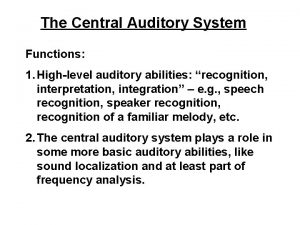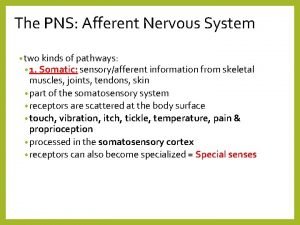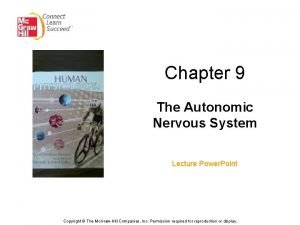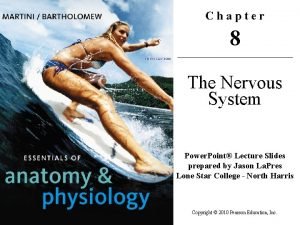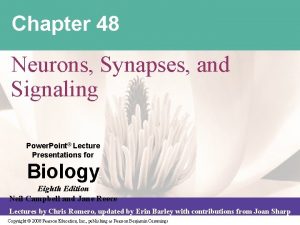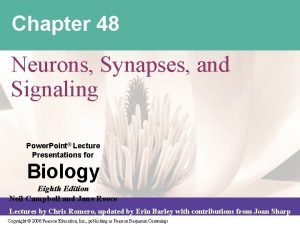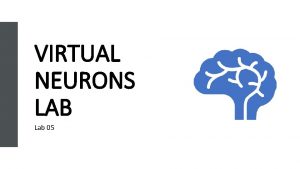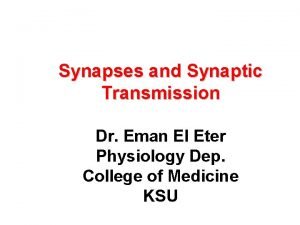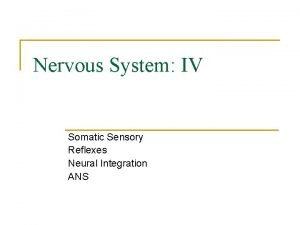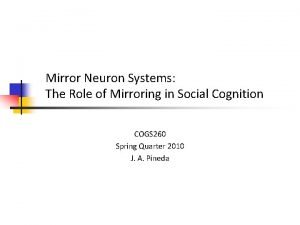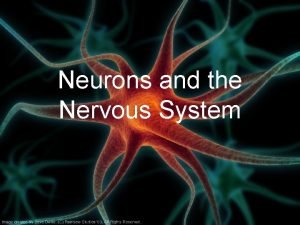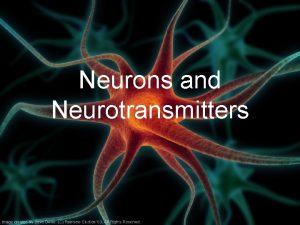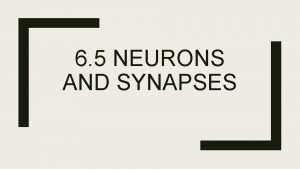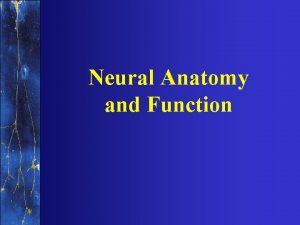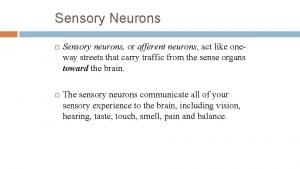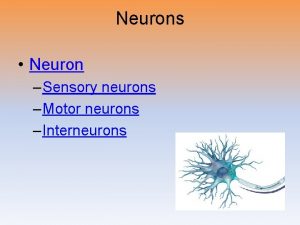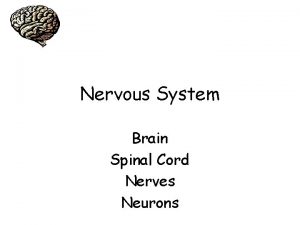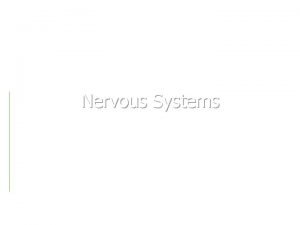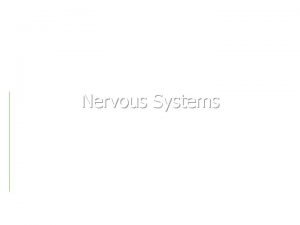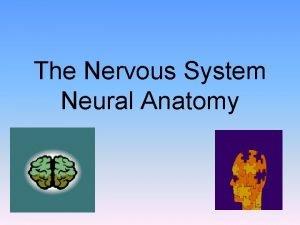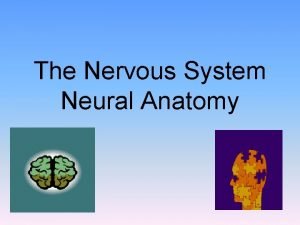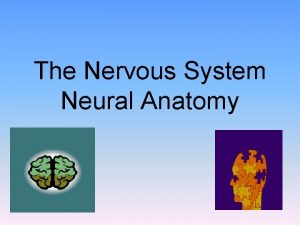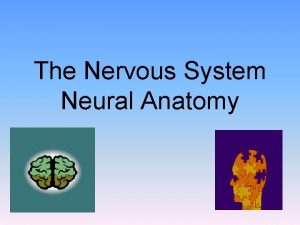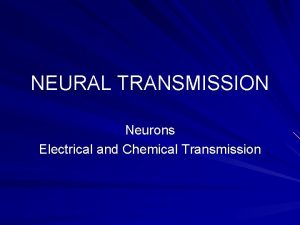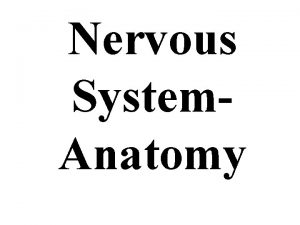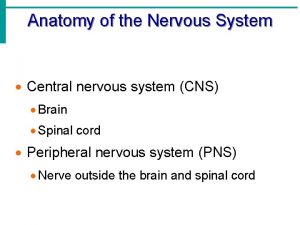Neurons and Neural Anatomy Nervous System Central nervous































- Slides: 31

Neurons and Neural Anatomy

Nervous System – Central nervous system (CNS): • Brain • Spinal cord – Peripheral nervous system (PNS): • Sensory neurons • Motor neurons (somatic and autonomic)

Copyright © The Mc. Graw-Hill Companies, Inc. Permission required for reproduction or display. The Nervous System Central Nervous System (CNS) Brain Peripheral Nervous System (PNS) Spinal Cord Motor Neurons Somatic Nervous System • voluntary movements via skeletal muscles Sensory Neurons Autonomic Nervous System • organs, smooth muscles Sympathetic - “Fight-or-Flight” responses Parasympathetic - maintenance

Copyright © The Mc. Graw-Hill Companies, Inc. Permission required for reproduction or display. Divisions of the autonomic nervous system

Cells of the Nervous System • There are 2 main kinds of cells – Neurons – Glial

Neurons § Basic units (cells) of the nervous system § Receive, integrate, and transmit information § Operate through electrical impulses § Communicate with other neurons through chemical signals

Glial cells • 100 billion neurons • 10 x more glial cells • Glial cells – Support neurons (literally, provide physical support, as well as nutrients) – Cover neurons with myelin – Clean up debris – Includes Schwann cells

Three main types of neurons

Three main types of neurons • Sensory Neurons (peripheral N. S. ) They transmit signals from the receptors to the central nervous system

Three main types of neurons • Sensory Neurons (peripheral N. S. ) They transmit signals from the receptors to the central nervous system • Interneurons (or association neurons) (central N. S. ) They process and integrate info to form a response

Three main types of neurons • Sensory Neurons (peripheral N. S. ) They transmit signals from the receptors to the central nervous system • Interneurons (or association neurons) (central N. S. ) They process and integrate info to form a response • Motor Neurons (peripheral N. S. ) Transmits the response from the CNS to effectors

Sensory (Afferent) vs. Motor (Efferent) sensory (afferent) nerve Neurons that send signals from the senses, skin, muscles, and internal organs to the CNS e. g. , skin motor (efferent) nerve Neurons that transmit commands from the CNS to the muscles, glands, and organs Gray’s Anatomy 38 1999 e. g. , muscle

Structure of a Typical Neuron

The Reflex Arc (or withdrawal reflex)

Neural Anatomy § Dendrite They receive messages from other neurons and conduct impulses toward the cell body

Neural Anatomy § Dendrite They receive messages from other neurons and conduct impulses toward the cell body § Cell Body It determines if the signal will be inhibited or relayed

Neural Anatomy § Dendrite They receive messages from other neurons and conduct impulses toward the cell body § Cell Body It determines if the signal will be inhibited or relayed § Axon It transmits the signal from the cell body to the axon terminal endings.

Neural Anatomy § Dendrite They receive messages from other neurons and conduct impulses toward the cell body § Cell Body It determines if the signal will be inhibited or relayed § Axon It transmits the signal from the cell body to the axon terminal endings. § Synapse • The gap between axon terminals and dendrites

Neural Transmission

Neural Transmission Along The Axon • Fatty material made by glial (Schwann) cells form the myelin sheath which insulates the neural transmission along the axon. • The transmission along the axon is due to Na-K pumps embedded in the membrane. These pumps “fire” in succession and initiate an electrical impulse called an action potential (AP). • In high speed transmission (Saltatory conduction), the impulse jumps gap to gap in the myelin sheath (Nodes of Ranvier).

Neural Transmission Along The Axon

The 3 Functions of the Neuron 1. 3. 2. Neurons = 3 functions: Reception, Conduction, Transmission

Action Potential (AP) • Depolarization: The stimulus “threshold” is reached and the sodiumpotassium pumps are activated and positively charged Na ions rush into to “fire” the pumps in succession.

Action Potential (AP) • Repolarized: At maximum depolarization, the sodium gates close and the potassium gates open. Positively charged K ions rush out of the neuron. • Refractory Period: The potassium gates close and, after a brief overshoot, resting membrane potential restored (~ 70 m. V)

The Action Potential is like a “Wave”

How an Action Potential Works

Saltatory Conduction

Neural Transmission At The Synapse

Synaptic Transmission • synaptic gaps = 1 millionth inch gap • Impulses reaching the pre-synapse will release neurotransmitter (NT) from vesicles into the gap

Synaptic Transmission • NT crosses the synaptic gap and binds to receptors on the post-synaptic membrane to initiate an AP on post-synapse • Enzyme in gap denatures NT • Denatured NT returned to pre-synapse to be reassembled and packaged into vesicles. • Impulse continues in the next neuron.

Examples of Neurotransmitters Receptor binding movie
 Fundamentals of the nervous system and nervous tissue
Fundamentals of the nervous system and nervous tissue Nervous
Nervous Processes of a neuron
Processes of a neuron Major division
Major division Nervous system of grasshopper
Nervous system of grasshopper Central nervous system amusement park
Central nervous system amusement park Cns
Cns Nervous system vocabulary
Nervous system vocabulary Bser aer
Bser aer Part of nervous system
Part of nervous system Central nervous system for kids
Central nervous system for kids Nervous system and digestive system
Nervous system and digestive system Adh function
Adh function Endocrine system vs nervous system
Endocrine system vs nervous system First second and third order neurons
First second and third order neurons Somatic motor cortex
Somatic motor cortex Stretch reflex
Stretch reflex Extrapyramidal tract
Extrapyramidal tract Pre ganglionic
Pre ganglionic Figure 8-2 neurons and neuroglia
Figure 8-2 neurons and neuroglia Chapter 48 neurons synapses and signaling
Chapter 48 neurons synapses and signaling Chapter 48 neurons synapses and signaling
Chapter 48 neurons synapses and signaling Endocrine vs nervous system venn diagram
Endocrine vs nervous system venn diagram Central nervous sysytem
Central nervous sysytem Virtual neurons
Virtual neurons Homunculus
Homunculus 1st order 2nd order 3rd order neurons
1st order 2nd order 3rd order neurons Properties of synapse ppt
Properties of synapse ppt Input neurons
Input neurons Proprioception autism
Proprioception autism Mirror neurons location
Mirror neurons location Input neurons
Input neurons








